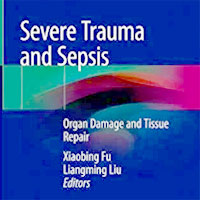Tag: sepsis

Targeting MAP in Sepsis
What’s your target mean arterial pressure (MAP) for patients with sepsis? Do you believe in the magic number of 65? What about those patients with chronic hypertension? What about when there is no evidence of end organ... read more

Adjuvant therapeutic plasma exchange in septic shock
The hallmark of sepsis is a pathological host response to an infection that may lead to organ dysfunction, shock and high mortality. Besides numerous circulating mediators initiating inflammation, vascular barrier breakdown... read more

Infectious Diseases A Clinical Short Course
Infectious Diseases: A Clinical Short COURSE is a concise overview of this important field designed to help the busy physician, medical student, nurse practitioner, and physician assistant to understand, diagnose, and treat... read more

Artificial Intelligence in Telemetry: What Clinicians Should Know
Advances in artificial intelligence are beginning to unlock the potential of telemetry data to directly inform diagnosis and personalized treatment. We can see hints of this in considering the case above. Is a second... read more

Accuracy of Heparin-Binding Protein in Diagnosing Sepsis
The diagnostic ability of heparin-binding protein is favorable, demonstrating both high sensitivity and specificity in predicting progression to sepsis in critically ill patients. Future studies could assess the incremental... read more

Severe Trauma and Sepsis: Organ Damage and Tissue Repair
This book discusses recent progress in organ damage and tissue repair following severe trauma and sepsis. In part 1, it introduces the theory and clinical practice in organ damage. In part 2, it covers all the subjects... read more

Necrotizing Pancreatitis: ED Presentation, Evaluation, and Management
A 40 year-old patient presents with increasing abdominal pain and a new fever. She initially presented to the Emergency Department five days prior for upper abdominal pain. The initial workup showed stable vital signs, mildly... read more

Two-Step Imputation and AdaBoost-Based Classification for Early Prediction of Sepsis on Imbalanced Clinical Data
Sepsis is a life-threatening response to infection that causes tissue damage, organ failure, and death. Effective early prediction of sepsis would improve patients’ diagnosis and reduce the cost associated with late-stage... read more

Childhood sepsis deadlier for Black patients
In this large, representative analysis of paediatric severe sepsis in the USA, we found evidence of outcome disparities by race or ethnicity and insurance status. Our findings suggest that there might be differential... read more

Impaired peripheral mononuclear cell metabolism in patients at risk of developing sepsis
Dysregulated immune response is a key driver of disease progression in sepsis and known to be associated with impaired cellular metabolism. This association has been studied mostly in the late stage sepsis patients. Here,... read more

Response to optic nerve sheath diameter guided detection of sepsis associated encephalopathy
regarding the blind method, being uninformed of the clinical diagnoses of patients is unavailing, since clues will still be found in patients' clinical manifestations. Therefore, two trained physicians in intensive ultrasound... read more

Apoptotic cells for therapeutic use in cytokine storm associated with sepsis
Sepsis has no proven specific pharmacologic treatment. Reported mortality in sepsis ranges from 30%-45%. This study was designed to determine the safety preliminary efficacy of allogenic apoptotic cells administered for immunomodulation... read more

Appendiceal Perforation at a Children’s Hospital During COVID-19 vs 2019
Although studies in the adult literature and case series in the pediatric literature have reported delays in medical care attributable to COVID-19, we report a statistically significant increased rate of appendiceal perforation... read more

Early prediction of impending septic shock in children using age-adjusted Sepsis-3 criteria
Sepsis is a syndrome which afflicts both adults and children, with many disease courses and diverse outcomes. Understanding of sepsis pathophysiology has changed over time; the Sepsis-3 criteria define sepsis in adults as... read more




